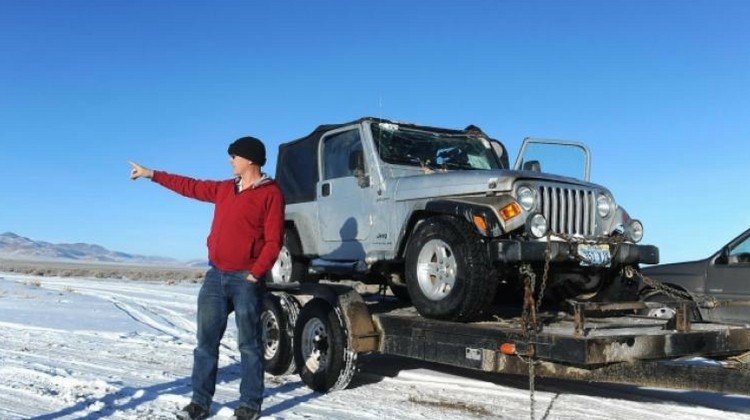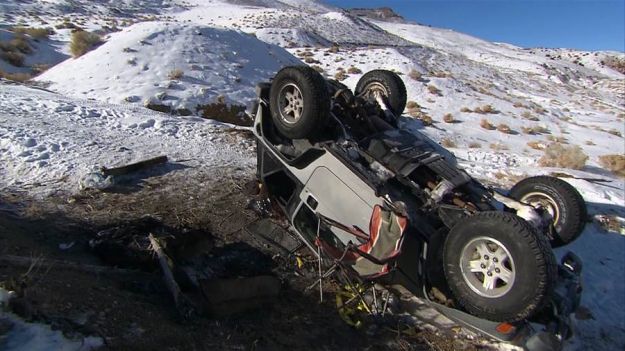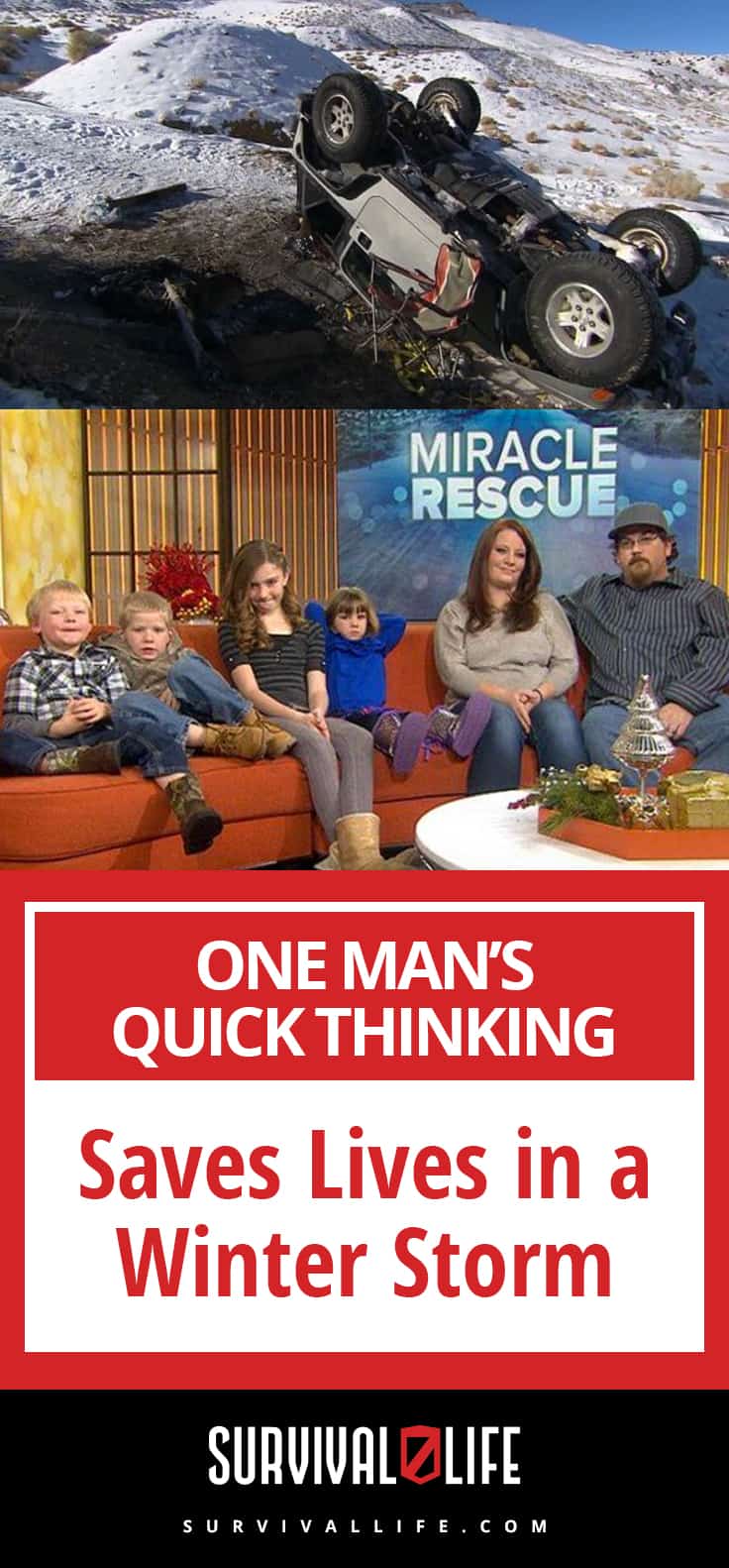Family
One Man’s Quick Thinking Saves Lives in a Winter Storm
Survival often requires quick thinking and even quicker action. Learn how one man rose to the challenge and saved lives in a recent snow storm.

A massive winter storm passed through the country in 2013, covering 67% of the U.S.. The country was covered in snow and ice! While unfortunately many were left without heat and power, some tried to make the best of it. But a quick jaunt through the snow can quickly turn into a survival situation if you're not prepared. You wanna go and ask for help but the storm will kill you before you could even find one. That leads to the question – If you're caught outside in the middle of winter, without supplies – How do you survive?
Man Saves Lives In A Winter Storm
One man's quick thinking recently saved his family and turned what would have otherwise been a recovery mission into a successful rescue. So what did he do?
(CNN) — The 2006 silver Jeep Wrangler with a black top carried the excited family of six into the back country of northwestern Nevada for a playful weekend outing in the snow. Those moments of adventure dissolved into a fight for survival after the vehicle turned over, slid down an embankment on its top and ended up in a crevice 15 miles from Lovelock. When dawn broke Monday to a temperature of 21 below zero, the situation for James Glanton, 34, and his girlfriend, Christina McIntee, and four children could have been desperate. Instead, they kept their heads. They didn't try to walk out of danger, thereby making it easier for rescuers to find them.
Those rescuers did find them about midday Tuesday, nearly 48 hours after the ordeal began. And, within hours, an incredible story of resourcefulness and steady nerves began to trickle out.
Check out this video on how the missing family survived the freezing Nevada wilderness.
Here's a look at the lucky survivors and the unfortunate event in the Northern Nevada mountains.
Overturned Jeep Wrangler

Image via today
This is how it looked like when rescuers spotted the overturned jeep. A search and rescue team was set out after the group failed to come back from a fun day trip in the snow.
Pershing General Hospital

Image via nbcnews
The family consisting of two adults and four children was found and rushed to Pershing General Hospital after they were lost in the freezing Nevada mountains. A miraculous story of survival for James Glanton and company.
The Survivors

Image via today
Six days after they were rescued, the survivors with James Glanton(far right) were interviewed by Savannah Guthrie in Today. They look perfectly okay after luckily surviving extreme cold temperatures.
Keeping warm
The couple, who were without extra blankets, started a fire outside after the Jeep overturned. They heated rocks and placed them in the spare tire to keep the children, ages 3 to 10, warm at night.
“I have never heard of such a thing, but I think it was pretty clever of him,” Paul Burke, who coordinated the rescue effort for the state Department of Public Safety, said of Glanton's tactics.
“To the extent he was ingenious about it, that is one for the books,” Burke told CNN on Tuesday evening.
When three residents finally found the family and their vehicle during a massive search, the family had little food left, so resident Salvador Paredes pulled a candy bar from his pocket and shared it with them.
Glanton and McIntee, 25, along with their two children — Evan and Chloe — and McIntee's niece and nephew, were taken to Pershing General Hospital.
This man's ingenuity saved his family from a very serious situation, and that shouldn't be taken away from him. But things could have been much different had he made sure his vehicle was properly stocked with cold weather emergency preps. With the children and situation their in, this is one heck of a survival story for the ages. Luckily the man in charge did not panic and used his superb survival skills to seal their survival.

Click here for a compilation of winter storm survival tips.
Feature Image Via – nydailynews
-

 Paracord Projects1 year ago
Paracord Projects1 year agoParacord Projects | 36 Cool Paracord Ideas For Your Paracord Survival Projects
-

 Paracord Projects1 year ago
Paracord Projects1 year agoHow To Make Paracord Survival Bracelets | DIY Survival Prepping
-

 Medical Care1 year ago
Medical Care1 year ago21 Home Remedies For Toothache Pain Relief
-

 Knife Laws1 year ago
Knife Laws1 year agoAre Switchblades Legal? Knife Laws By State
-

 Do It Yourself1 year ago
Do It Yourself1 year agoSurvival DIY: How To Melt Aluminum Cans For Casting







DK
December 13, 2013 at 3:52 PM
A set of jumper cables. I don’t know how often I have had a dead battery from the cold. Can also be used to start a fire in a pinch.
A gallon or two of extra gas. If stuck in one spot it can give several hours for heat from the car engine. Do not run continuous. Warm up the car then shut it down. Also useful to help start a fire. But be careful. Gasoline is explosive.
gena
December 13, 2013 at 4:15 PM
I bought a fairly inexpensive battery charger which I keep in my car now and which can power small devices as well, and bought a small device you can use in car charging socket or lighter socket to heat food or even cook hot dogs. You can use any device with a DC plug with the battery charger. I try to make sure it is charged and ready at all times, taking it inside to keep it charged periodically with an overnight plug into 110 outlet. Also have a power inverter for the car, which, again will allow use of devices from the car battery. You do NOT want to use that too extensively without running engine at same time, will run down your battery. Course if you have the charging device you can recharge it if it runs down, at least once or twice.
David Fisher
December 13, 2013 at 4:00 PM
Nice article and good advice. Thanks.
rontello
December 13, 2013 at 4:03 PM
Tips?
“Stay home!”.
Walter Pachao
December 17, 2013 at 5:22 PM
That would be the best survival advice. You may have a 4 wheel drive vehicle but it does not mean you’re going to be safe especially in isolated areas in bad weather. Stay home and don’t put yourself into a potentially dangerous situation.
Turfguy
January 11, 2014 at 11:24 PM
Yeah, stay home & live a boring life. Never take risks. Never have stories to tell your kids & grandkids. Then die of boredom at an old age. No thanks
gena
December 13, 2013 at 4:09 PM
One or two entire MRE meals wouldn’t take that much room and have enough food in them for several people, especially if kids are involved, to last a couple of days, minimum, to keep people fed enough to survive. Also would crowd people as close together as possible to share body heat, might not be all that comfortable but does wonders to keep everyone warmer than otherwise possible. If your exhaust pipe is free of cover, turning the heat on periodically, for short periods of time can provide enough heat to keep people thawed out. Had to do that once when caught out in an unexpected snow storm, where the police tried to get me to go to a homeless shelter overnight, but had my pets in the car. Told the cops the dogs and cats and I would keep each other warm, I was right, in fact we generated so much body heat it frosted the inside of the windows since it was so much warmer inside than outside. Only had to turn the heat on twice during the night to supplement our body heat. We were in a Walmart parking lot, too crazy a situation to go into why, but were caught so unaware, did not know cold front was coming, had no coat or sweatshirt available, late enough in the year they had no coats for sale, bought a sweatshirt and we did fine. I could have taken refuge inside the store but needed to be out to protect my pets. Had eight dogs, seven or eight cats and a couple guinea pigs, a ferret and a sugar glider with me in a nonextended cab Ford Ranger. We did just fine. Sleeping with dogs and cats over and under me kept all of us warm, car did stink by morning. 🙂 Did go to a convenience store during the night to buy hot coffee and so I could use the heat with no worry of CO poisoning. Really was a good learning experience which I will hopefully not go through again but know I can deal with it if necessary. Now always have bug out bag in the truck at all times, this was 12 years ago.
Bob
December 13, 2013 at 4:14 PM
Very good advice above. I would add to that list a nice package of magnesium road flares and signal rockets. Will burn even when under water in case your only clear area to signal from is a stream, start a fire when even the tinder is damp due to their intense heat and length of burning and of course can be seen a long distance as a signal. Signal rockets help draw attention when you’re physically unable to be seen, like down in a ravine.
Jerry
December 13, 2013 at 4:53 PM
I live at 9000 feet and carry a survival kit in each of our cars.
During winter months the following items are added:
BLack plastic bag to pack snow into and melt on car roof for drinking.
Long burning candle and Tin cup to melt snow in if there is no sun.
Candle also heats the car interior at night.
Two wool blankets to wrap up in.
charles lea
December 13, 2013 at 6:40 PM
might also add a bright orange vest or blanket…easier to see in snow
Dave
December 13, 2013 at 6:49 PM
Two adults and four children (ages 3 – 10) in a 2006 2 door Jeep Wrangler. A safety issue befor they even got out of their driveway. One child seat takes half the back seat.
rev. dave
December 13, 2013 at 7:11 PM
For winter weather you need matches and a big fat candle. If you simply crack your window for a little air circulation, one candle can keep an entire car warm. You need a big fat one to burn all night. For really remote places or REALLY cold weather, you might need more candles, so pack 3 or so, depending on your location and winter weather.
It wouldn’t hurt to have a big bright orange insulated cover-all in the vehicle too, sized to fit over your clothes.
No body at my house
December 13, 2013 at 8:06 PM
I don’t live up north but maybe something bright orange like a hand towel or bandana to place beside the road where vehicle wrecked. Maybe more than one to lead way to where survivors are located.
BrooklynResident
December 13, 2013 at 9:06 PM
Don’t forget one of those blue plastic tarps. Some light rope to tie it in place. A s it’s plastic, you could even paint one side bright orange, put a white X in the middle. If it’s big enough, you could make a shelter–floor, one side, rain shelter. Keeping dry is important.
If you’re thinking of a crashed vehicle- it’s possible you may not be able to stay in it safely.
BrooklynResident
December 13, 2013 at 9:09 PM
Don’t forget one of those blue plastic tarps. Some light rope to tie it in place. A s it’s plastic, you could even paint one side bright orange, put a white X in the middle. If it’s big enough, you could make a shelter–floor, one side, rain shelter. Keeping dry is important.
If you’re thinking of a crashed vehicle- it’s possible you may not be able to stay in it safely.
And…I always keep a lens on my person–an easy way to start a fie if the sun’s out.
Kim
December 13, 2013 at 9:27 PM
I keep a small duffel bag in the trunk with a sweatshirt, sweat pants, a couple pair of socks (can use on the hands if needed) and full rain gear (jacket with hood, pants and boots). The rain gear is handy in all types of weather to keep off rain, wet snow and wind. I have used it and the boots were a godsend one year when I had a flat tire. I would have had frozen feet without them!
Paul
December 13, 2013 at 10:27 PM
You should carry coconut oil or lard for skin protection against the wind or to eat for energy. The coconut oil is also medicine. Vaseline can be used for skin protection, chapped lips or starting fires with cotton . You can also carry honey for energy and wound treatment. Salt for seasoning what you might have to eat that you don’t want to eat . You should have a good strong tow rope or chain in case someone can pull you out . Aspirin, good for pain and also might help your battery get one more turn over by putting one in each cell. Paper and pencil , good survival book that don’t take up to much room. Machete or good hatchet . Hand foot warmers . On and on it can go , you would rather have it and not need it than need it and not have it.
David Daly
December 13, 2013 at 10:42 PM
Keep the car fuel tank at least half full, or for short-term, no less than a quarter tank.
Connie
December 13, 2013 at 11:06 PM
I’m not much of a survivalist, but my Dad taught me when traveling in winter to keep a sleeping bag with pillow, a bag of kitty litter, and a small snow shovel in my trunk. He always carried a small backpack with him almost everywhere he went with emergency supplies and FOOD, but wasn’t as persistent in teaching me to do that (he was a Navy man). Later in life, when commuting to work in winter, I would drive from my garage to my workplace underground parking garage, so I would often dress lightly with high heels and nylon stockings, skirt and jacket when I drove off for work in the morning. But after thinking about what would happen if I got stuck in snow, I started keeping snow boots, warm socks, insulated gloves, a wool sweater, wool hat, and a warmer winter coat in my car. Then if I got stuck in a snowbank, I wouldn’t have to skid around on high heels while trying to walk home or walk for help! I also drove a little Honda Civic with front-wheel drive, so many times when an unexpected snow storm snarled traffic, and cars around me were unable to make it to the top of hills, my Civic would go right on up and maneuver around the stalled and backward-sliding bigger cars with the rear-wheel drive! I LOVED that!!!
john
December 13, 2013 at 11:33 PM
wHY DID HE NOT FILE A PLAN WITH FRIENDS WITH ROUTE AND ETA TO INFORM AUTHORITIES IF HE DID NOT ARRIVE. Glad they were all OK
Al
December 14, 2013 at 12:53 AM
I live in interior Alaska and any roadtrip can end up like these folk’s one did. Many good tips here. A few that I would add would be a quality sleeping bag for each person, extra warm clothes and winter boots like Sorrels, Mukluks or Bunny boots if not worn, at least in vehicle. A good hatchet for cutting firewood.
Be safe and Merry Christmas!
Al
Pam Carver
December 14, 2013 at 1:36 AM
a small shovel- dig yourself out or remove snow so your exhaust pipe is clear. Sand bag— weight to keep car from fish tailing or if you get stuck use for t\raction.To help in stopping on ice gear down to the lowest gear and gently pump your brakes if the car slides turn it into your slideChains are really helpful on ice. Go SLOW dRIVE LIKE THE OTHER DRIVER IS AN IDIOT AND DOESN’T KnOW WHAT THEY ARE DOING.I’m living where we rarely have snow but when we get it it usually turns icy really fast.I grew up with snow for about 6-9mos of the year
SF Daddy
December 14, 2013 at 12:16 PM
As a retired special operator, I try to pass on my years of experience to the next generation through the Boy Scouts, 4H, ROTC and the CAP. The basic tenets we teach are the Rule of Threes, the Pocket Item list and the famous Ten Essentials. Simply, you NEVER go out of the house without your Pocket Items (except, unfortunately, to public school), you NEVER go in the woods or on the water without your Ten Essentials, and finally, wherever you are, you need to know and be prepared to take care of your body’s basic needs, by priority, using the Rule of Threes. You can find different versions of the Rule of Threes and the Ten Essentials on the web and in the various youth handbooks like the Boy Scout Handbook. Our Pocket Item list was gleaned from the DoD survival manuals, the BSA Handbook, the Fundamentals of SAR teaching notebook and the National Park Service SAR documents. The Pocket Items are:
one red bandana for first aid
one blue bandana for collecting/filtering water and utility uses
one white bandana for personal hygiene
one Storm whistle
one old CD for signalling
one bright orange 4 mil plastic garbage bag
one multi-tool or Swiss army knife
one granola bar or package of chewing gum or baggie of hard candies
one ferocium stick metal match
Another good source of information is the various state Fish and Game Service of which the Alaska Department is one of the best. Their website is:
http://www.adfg.alaska.gov/index.cfm?adfg=hunting.firstaid
As they say, get trained in advanced first aid and CPR before you need it to save your loved ones or yourself.
Our Boy Scouts and Cadets train in the NY north country year round. We teach them to always travel in their vehicles with signalling devices, sleeping bags, shovel, axe, sand or kitty litter, towing strap or chain, first aid kit, water jug, metal pot or large canteen cups, orange tarp and ropes, a food pack, jumper cables, duct tape, metal wire and a set of tools for working on the vehicle.
So, as we say in the Teams and in Scouts, it pays to be a winner and Be Prepared to help other people at all times. Cheers.
Dan Lane
December 14, 2013 at 3:20 PM
After reading some of the comments I really like the one about signal flares or rockets. I have found that a simple flare pistol for boats with extra flares works very nice for emergency situations. I have not used them in a car but have on a boat and I think in a winter environment the chances of starting a wild fire are minimal. Use them when you hear a search and rescue aircraft or vehicle. Works great for starting a fire with wet wood also.
Pam Carver
December 15, 2013 at 2:53 AM
Carry a small shovel– dig out exhaust pipe or get tractionSand — weight to avoid fishtailing orfor traction. Chains — for ice.Drive slowly to allow ample stopping timeUse your lower gears to brake. gently pump the brakes. if you slide turn into the way you are turning vs correcting in the oppposite direction. Drive like the other drivers are idiots — most people don’t know how to drive on snow and ice
Mike
December 15, 2013 at 10:47 PM
A lot of good tips & advice on here & in the other comments.
However, Something I haven’t seen anyone mention, cause most people don’t think about, that I always make sure to keep in my vehicle in addition to some of the other things mentioned by others is A Roll of TOILET PAPER.
You just never know when you may be stuck somewhere & “Need to go”.
Plus, it could be used to start fire, ect.
I try to always keep an extra roll in a Ziploc bag, so it doesn’t get wet, dirty, or anything & stays fairly fresh & clean.
Russ
December 15, 2013 at 11:10 PM
I always carry a small strno can ,and stove in the trunk with some road flairs, a cooler with water, some food ,coffee, hot coco, a wool blanket , water proof tarp. a shovel and tire chains ,extra gas , a machetty , to chop wood for a fire. and some para coard , and a steel cup and pot.just some of the things 1 might need in a pinch. hope this helps.
Boris The Red
December 16, 2013 at 11:54 PM
I hail from Russia, from its northern part, near Murmansk and Finland. Cold is part of my childhood. Knowing how to deal with it is what gave us Russians the fame of being in love with the cold. Sure, we tolerate it better than most people, but that’s because we know how to enjoy it without being overcome by it. In my car, besides a rolled up mat and a tent, I also have a large bright piece of tarp (I want to be seen by rescuers), a bundle of rope (about 50 feet), three flashlights (one is a cranck recharger and has a radio and a siren), an axe, a multitool folding knife, a large knife (and few small ones), basic first aid kit, a whistle, a box of matches, a plastic container with matches (yes, redundancy), two different types of lighters (one of them is wind-proof), steel and flint, liter bottles of water all over, packs of beef jerky (I love the taste), protein bars, small amounts of nuts, dried figs and dates. I also have two pairs of winter gloves, three pairs of socks, one extra pair of underwear, one long-sleeve flannel shirt, one sweater, two beanie hats, one neoprene face mask, set of thermal underwear (top and bottom), and winter boots. Except for the axe, the boots, the mat, and the tent, all fits into a medium-size backpack. It takes less space in my mid-size sedan than you would think, but trade-off is — I KNOW I’m prepared.
TJ Shine
February 7, 2014 at 1:49 PM
Finally…Somebody said FLASHLIGHT! A flashlight is a must in every car, every season, for obvious reasons. Even when the batteries are dead, the reflector can be used for signaling (and a good little funnel). The main casing can be a drinking cup and canteen by removing the batteries and re-assembling it. As a retired Navy Corpsman, I carry a large first-aid bag that has, in addition,two small lighters, 25 foot paracord strap, and alcohol pads (easy fire starters). Road flares are a must in every vehicle as well.
DOUG T.
December 18, 2013 at 4:41 AM
Have lived in MN my whole life and strarted plowing snow w/my Dad about age 8. Some of this will depend on the size+type of car/truck you have. What I currently keep in my 4wd,regcab,shortbox truck is, jumper cables,2 tow straps,xtra gloves,boots,coveralls,stocking cap,sm bnkt/fender cover,sm roll of plastic sheeting,flash lt,tire chains,1 can fix-a-flat,sm shovel (one of those folding camp shovels is fine) Just anything to move snow/ice etc., knife,pkg type hand+foot warmers-5pks,screw drivers,vise grips etc. and I used to have a 3,000lb 12v winch that I could strap to the frt or rear and run remotely. Some may think it’s overkill, but I go where and when I want, or need to, and always make it back. (usually assisting someone in the ditch along the way) Another thing,again…if you have room…is an old fashoned bumper/farm type jack. You would be amazed at what you can get a vehical out of with one of those! Last and shouldn’t need to be said but….good tires at correct inflation,and all maint. up to date,lt’s checked etc. If you know somethings not quite right with your car….don’t go out in bad weather! You WILL break down!
Safe travels!
Doug T.
Ryan Moeller
December 19, 2013 at 12:00 PM
In an emergence like the one above everyone should remember this it could be the one thing that saves your life. If you have a kit or not you have 5 tires on your car (including the spare). Dont be afraid to burn them. If you ever have then you know why im saying this. A burning tire will burn for a long time, put off a good amount of heat and make a lot of black smoke which will help people find you. just be careful as the smoke is toxic. Never the less by burning it your staying warm and telling people where you are. A tire is a small price to pay to stay alive. I hope no one ever has to do this but its a great thing to keep in mind.
Be smart people,
Ryan Moeller
Pingback: Do You Have A Home Disaster Survival Kit? Here's How To Make One